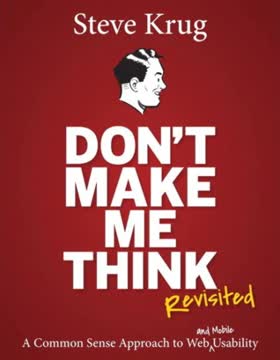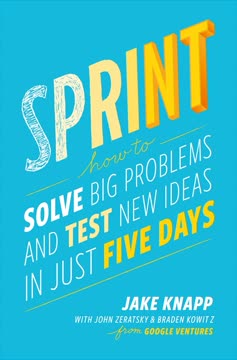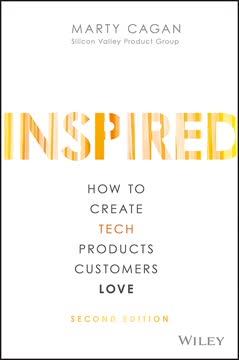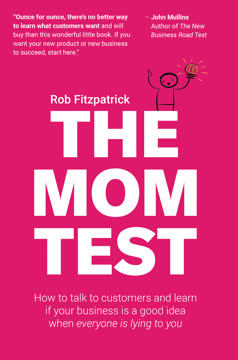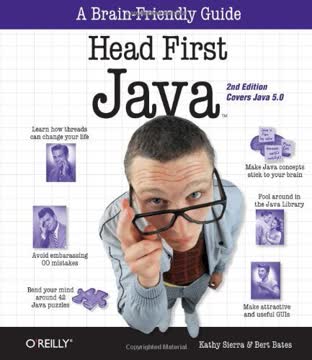نکات کلیدی
1. کاربران قوی بسازید، نه فقط محصولات قوی
"آنها نمیخواهند در کار ما قوی باشند. آنها میخواهند در کاری که با آن انجام میدهند قوی باشند."
تمرکز خود را تغییر دهید. به جای اینکه فقط بر بهبود محصول خود تمرکز کنید، بر روی بهتر کردن کاربران در استفاده از آن تمرکز کنید. این رویکرد منجر به موفقیت پایدارتر و رشد ارگانیک از طریق توصیههای دهان به دهان میشود.
موفقیت کاربر، موفقیت محصول را به همراه دارد. وقتی کاربران به مهارتهای بالایی دست پیدا میکنند و نتایج چشمگیری با محصول شما به دست میآورند، به طور طبیعی بهترین حامیان آن میشوند. این یک چرخه بازخورد مثبت ایجاد میکند که در آن برتری کاربر، پذیرش محصول و بهبود بیشتر را تقویت میکند.
مزایای کلیدی تمرکز بر تخصص کاربر:
- افزایش رضایت و وفاداری کاربر
- بازاریابی دهان به دهان واقعیتر
- افزایش ارزش درک شده محصول شما
- تمایز در بازارهای شلوغ
2. به کاربران در عبور از منطقه دشواری کمک کنید
"بزرگترین مشکل برای اکثر افراد در اکثر منحنیهای تخصص، داشتن تعداد زیادی کار در تابلو B است."
مشکل را بپذیرید. به این نکته توجه کنید که یادگیری مهارتهای جدید معمولاً شامل یک "منطقه دشواری" است که کاربران احساس ناتوانی و ناامیدی میکنند. با پرداختن به این مرحله بهطور علنی، میتوانید به کاربران کمک کنید تا از آن عبور کنند.
حمایت هدفمند ارائه دهید. تجربه کاربری اولیه و فرآیند ورود به سیستم خود را طوری طراحی کنید که زمان صرف شده در منطقه دشواری را به حداقل برسانید. مهارتهای پیچیده را به زیرمهارتهای کوچکتر و قابل مدیریت تقسیم کنید که کاربران بتوانند به سرعت آنها را تسلط یابند.
استراتژیها برای کمک به کاربران در عبور از منطقه دشواری:
- انتظارات واقعبینانه درباره دشواریهای اولیه تعیین کنید
- تشویق و اطمینان دهید که مشکلات طبیعی هستند
- نقاط عطف واضح و قابل دستیابی برای نشان دادن پیشرفت ارائه دهید
- پیروزیهای کوچک را جشن بگیرید تا انگیزه را افزایش دهید
3. تمرین هدفمند را برای توسعه مهارتها پیادهسازی کنید
"تمرین به معنای کمال نیست. در علم تخصص، نوعی از تمرین صریح که بهطور مؤثر کار میکند، به عنوان تمرین هدفمند شناخته میشود."
بر روی تمرین با کیفیت تمرکز کنید. تمرین هدفمند شامل تقسیم مهارتها به اجزای کوچک و خاص و تمرین آنها بهطور فشرده با بازخورد فوری است. این رویکرد بسیار مؤثرتر از تکرار صرف وظایف بدون یک برنامه ساختاریافته است.
تمرینهای مؤثر طراحی کنید. تمرینهایی ایجاد کنید یا پیشنهاد دهید که به کاربران اجازه دهد در یک زیرمهارت خاص در ۱-۳ جلسه تمرین ۴۵-۹۰ دقیقهای به ۹۵٪ قابلیت اطمینان دست یابند. اگر این هدف قابل دستیابی نیست، مهارت را بیشتر تقسیم کنید یا معیارهای عملکرد را تنظیم کنید.
عناصر کلیدی تمرین هدفمند:
- وظایف خاص و بهخوبی تعریف شده
- سطح دشواری مناسب (چالشبرانگیز اما قابل دستیابی)
- بازخورد فوری و اطلاعاتی
- فرصتهایی برای تکرار و اصلاح
4. از قرارگیری ادراکی برای یادگیری ناخودآگاه بهرهبرداری کنید
"فقط قرار گرفتن در معرض نمونههای تخصصی بهطور خودکار دانش ادراکی ایجاد نمیکند، مگر اینکه قرارگیری معیارهای خاصی را برآورده کند."
یادگیری ناخودآگاه را به کار بگیرید. قرارگیری ادراکی به کاربران اجازه میدهد تا بدون تلاش آگاهانه، شناسایی الگوهای عمیق و شهود را توسعه دهند. این میتواند بهطور چشمگیری سرعت یادگیری مهارتها را در حوزههای پیچیده تسریع کند.
تمرینهای قرارگیری مؤثر طراحی کنید. تجربیاتی ایجاد کنید که کاربران را در یک بازه زمانی فشرده به تعداد زیادی از نمونههای باکیفیت قرار دهد. این به مغز آنها کمک میکند تا الگوها و ساختارهای زیرین را شناسایی کند.
راهنماها برای قرارگیری ادراکی:
- از مجموعهای بزرگ و متنوع از نمونههای باکیفیت استفاده کنید
- پس از قرارگیری، بازخورد فوری ارائه دهید
- بر روی نمونههای برتر تمرکز کنید و قرارگیری در معرض نمونههای ضعیف را به حداقل برسانید
- اجازه دهید که قرارگیری مکرر در طول زمان انجام شود
5. نقشه مسیر عملکرد واضحی طراحی کنید
"نقشه مسیر عملکرد ایدهآل: مراحل واضح پیشرفت از مبتدی به حرفهای."
نقشهای برای تخصص ارائه دهید. یک پیشرفت واضح و مرحله به مرحله ایجاد کنید که به کاربران نشان دهد چگونه از سطح مبتدی به سطح کارشناس پیشرفت کنند. این به آنها اعتماد به نفس در فرآیند یادگیری میدهد و انگیزه بهبود مستمر را افزایش میدهد.
بر روی مهارتهای قابل نمایش تمرکز کنید. به جای اینکه فقط موضوعات یادگیری را فهرست کنید، مهارتها و قابلیتهای خاصی را تعریف کنید که کاربران باید در هر سطح بتوانند نشان دهند. این باعث میشود پیشرفت ملموستر و پاداشدهندهتر باشد.
اجزای یک نقشه مسیر عملکرد مؤثر:
- سطوح مهارت بهخوبی تعریف شده (مثلاً مبتدی، متوسط، پیشرفته، کارشناس)
- قابلیتهای خاص و قابل اندازهگیری برای هر سطح
- منابع یادگیری و فعالیتهای تمرینی پیشنهادی
- روشهای ارزیابی برای تعیین سطح فعلی و پیشرفت
6. پیروزیهای اولیه و مزایای مستمر ارائه دهید
"مهم نیست که آیا کاربران ما در حال بهتر شدن هستند یا نه، مگر اینکه بدانند در حال بهتر شدن هستند و از بهتر شدن بهرهمند میشوند."
ارزش فوری ایجاد کنید. محصول و تجربیات یادگیری خود را طوری طراحی کنید که به کاربران قابلیتهای معناداری در ۳۰ دقیقه اول استفاده ارائه دهد. این اعتماد به نفس و انگیزه برای ادامه را ایجاد میکند.
مزایای مداوم را تضمین کنید. سفر یادگیری را طوری ساختاربندی کنید که جریان ثابتی از قابلیتهای جدید و مفید ارائه دهد. هر مرحله باید بهبودهای ملموسی در آنچه کاربران میتوانند انجام دهند، باز کند.
استراتژیها برای پیروزیهای اولیه و مزایای مستمر:
- شناسایی و آموزش "سوپرپاورهای" با تأثیر بالا در اوایل سفر کاربر
- مهارتهای پیچیده را به اجزای کوچکتر و سریعاً قابل دستیابی تقسیم کنید
- پیشرفت کاربران را بهطور منظم برجسته و جشن بگیرید
- هر قابلیت جدید را به کاربردها و مزایای دنیای واقعی متصل کنید
7. منابع شناختی کاربران را بهطور مؤثر مدیریت کنید
"همیشه بپرسید، 'کاربران من میخواهند منابع شناختی ارزشمند خود را کجا صرف کنند؟ چه کاری میتوانیم انجام دهیم تا کمک کنیم؟ چه کاری انجام میدهیم که آسیب میزند؟'"
بار شناختی را به حداقل برسانید. به این نکته توجه کنید که اراده و پردازش شناختی از یک منبع محدود از منابع ذهنی تغذیه میکند. محصول و تجربیات یادگیری خود را طوری طراحی کنید که بار شناختی غیرضروری را به حداقل برسانید.
کار را به محیط واگذار کنید. هر زمان که ممکن است، کار شناختی را از ذهن کاربر به محیط خارجی منتقل کنید. این منابع ذهنی را برای کارهای مهمتر آزاد میکند.
تکنیکها برای حفظ منابع شناختی:
- از رابطهای واضح و شهودی استفاده کنید که نیاز به حفظ کردن نداشته باشند
- برگههای راهنما و منابع قابل دسترسی آسان ارائه دهید
- برای "دانش در جهان" طراحی کنید نه "دانش در ذهن"
- به کاربران کمک کنید عادتهای خودکار برای کارهای روزمره توسعه دهند
- سوالات و نگرانیهای رایج کاربران را پیشبینی و بهطور پیشگیرانه حل کنید
8. از زمینههای جذاب برای دور زدن فیلتر هرزنامه مغز استفاده کنید
"باید چیزی که کاربر ما میخواهد انجام دهد را با چیزی که مغز کاربر ما به آن اهمیت میدهد، ترکیب کنیم."
آن را احساسی کنید. سیستم توجه مغز به اطلاعات عاطفی، شگفتانگیز یا بالقوه تهدیدآمیز تمایل دارد. از این به نفع خود استفاده کنید و اطلاعات مهم را بهگونهای ارائه دهید که واکنشهای عاطفی را تحریک کند.
به زمینههای معنادار متصل شوید. همیشه اطلاعات و مهارتها را در زمینه بزرگتر و جذابی که کاربران به آن اهمیت میدهند، قاببندی کنید. این به مغز کمک میکند تا اهمیت آنچه را که در حال یادگیری است، شناسایی کند.
استراتژیها برای جلب و حفظ توجه:
- از مثالها و داستانهای زنده و عاطفی استفاده کنید
- عناصر غیرمنتظره یا شگفتیها را وارد کنید
- مفاهیم انتزاعی را به سناریوهای واقعی و ملموس متصل کنید
- از تصاویری استفاده کنید که واکنشهای قوی را برانگیزد (مثلاً مقایسههای قبل و بعد)
- حس فوریت یا اهمیت را در اطراف نکات کلیدی یادگیری ایجاد کنید
آخرین بهروزرسانی::
FAQ
1. What’s Badass: Making Users Awesome by Kathy Sierra about?
- User-Centric Success Formula: The book explores why some products and services achieve sustained success, arguing that the secret lies not in the product itself, but in making users more skilled, confident, and “badass” at what they want to do.
- Shift from Product to User: Instead of focusing on making a better product, Sierra advocates for making better users—helping them achieve meaningful results and experiences.
- Science of Expertise: The book draws on research in expertise, motivation, and cognitive science to provide actionable strategies for helping users progress from novice to expert.
- Practical, Actionable Framework: It offers a step-by-step approach for product creators, designers, and businesses to foster user mastery, intrinsic motivation, and authentic word-of-mouth advocacy.
2. Why should I read Badass: Making Users Awesome by Kathy Sierra?
- Sustainable Success Insights: If you want your product or service to achieve long-term, word-of-mouth-driven success, this book provides a proven, research-backed approach.
- Applicable to Any Field: The principles apply to software, hardware, services, education, and more—anywhere users interact with tools or experiences.
- Counterintuitive, Fresh Perspective: Sierra challenges conventional wisdom about marketing, engagement, and product design, offering a user-first mindset that’s both ethical and effective.
- Actionable Techniques: The book is filled with practical exercises, examples, and frameworks you can implement immediately to help your users become more capable and enthusiastic.
3. What are the key takeaways of Badass: Making Users Awesome by Kathy Sierra?
- User Results Drive Success: The most successful products are those that help users achieve impressive, meaningful results in a larger context—not just those with the best features.
- Word of Mouth is Key: Honest, enthusiastic recommendations from users are the most powerful driver of sustained success, and these are inspired when users feel awesome about themselves, not just the product.
- Expertise is Built, Not Born: Anyone can become “badass” with the right support, practice, and exposure to high-quality examples—natural talent is rarely a limiting factor.
- Reduce Cognitive Leaks: Products and experiences should minimize unnecessary cognitive load, allowing users to focus their mental resources on learning and mastery, not on overcoming confusing interfaces or instructions.
4. How does Kathy Sierra define “badass users” in Badass: Making Users Awesome?
- Users with Superior Results: Badass users are those who achieve superior, consistent results in a meaningful context using your product or service.
- High-Resolution Experience: They perceive more detail, make better choices, and have richer, more rewarding experiences in their domain.
- Intrinsic Motivation: These users are intrinsically motivated, often evangelizing and showing off their results because they feel empowered and skilled.
- Not Just Product Experts: The focus is on being badass at what the product enables (e.g., photography), not just at using the product itself (e.g., the camera).
5. What is the main method or framework in Badass: Making Users Awesome by Kathy Sierra?
- Focus on User Progress: The core framework is about helping users move up the “user journey curve” from beginner to expert in the larger, compelling context your product supports.
- Deliberate Practice & Perceptual Exposure: Sierra emphasizes two key drivers of expertise: deliberate practice (focused, feedback-driven skill-building) and high-quality exposure to expert examples.
- Remove Blocks, Not Just Add Motivation: Instead of just trying to motivate users, the method focuses on removing obstacles and “cognitive leaks” that derail progress.
- Performance Path Maps: The book advocates creating clear, credible paths for user progress, with milestones and early payoffs to keep users motivated and aware of their growth.
6. How does Badass: Making Users Awesome by Kathy Sierra suggest you create word-of-mouth and “word of obvious” for your product?
- Enable User Success Stories: When users achieve impressive results, they naturally want to share their experiences, leading to authentic recommendations.
- Make Results Visible: Sometimes, users’ results are so obvious (e.g., a stunning photo) that others ask about the tool or method—this is “word of obvious.”
- Focus on User Identity: Help users become the kind of person they want to be (e.g., a great photographer), not just someone who uses your product.
- Avoid Faux-Badassery: Don’t rely on gamification or superficial rewards; focus on real skill and meaningful progress that users value intrinsically.
7. What is the “compelling context” concept in Badass: Making Users Awesome by Kathy Sierra, and why is it important?
- Beyond the Tool: Compelling context refers to the larger, meaningful activity or goal your product enables (e.g., photography, not just cameras).
- User Motivation Lives Here: Users are motivated by what they can do or become, not by the tool itself—design everything around helping them succeed in this context.
- Drives Desire for Upgrades: As users get better in the compelling context, they naturally appreciate and desire higher-end tools and features.
- Sustains Engagement: Focusing on the compelling context keeps users progressing and prevents them from plateauing at “competent” but unenthusiastic.
8. How does Badass: Making Users Awesome by Kathy Sierra explain the science of expertise and skill-building?
- Deliberate Practice: True expertise is built through focused, feedback-driven practice on fine-grained sub-skills, aiming for reliability and mastery.
- Perceptual Exposure: Exposure to a high quantity of high-quality examples (with feedback) helps users develop unconscious pattern recognition and intuition.
- Continuous Progress: Experts never stop adding new skills or refining existing ones; they also revisit and “de-automate” skills to avoid stagnation.
- Natural Talent is Overrated: Most people can achieve high levels of skill with the right kind of practice and exposure—support and encouragement matter more than innate ability.
9. What are “cognitive leaks” and how does Badass: Making Users Awesome by Kathy Sierra recommend reducing them?
- Definition of Cognitive Leaks: Cognitive leaks are unnecessary drains on users’ mental resources, caused by confusing interfaces, excessive choices, or unclear instructions.
- Reduce Unnecessary Choices: Minimize the number of decisions users must make, especially early on—provide trusted defaults and recommendations.
- Delegate Knowledge to the World: Use cheat sheets, labels, and affordances so users don’t have to memorize or recall information unnecessarily.
- Just-in-Time Learning: Present knowledge only when it’s needed, not “just in case,” to avoid overwhelming users and triggering the brain’s “spam filter.”
10. How does Badass: Making Users Awesome by Kathy Sierra address user motivation and progress?
- Remove Obstacles, Don’t Just Motivate: Focus on identifying and removing what stops users, rather than just trying to pull them forward with incentives.
- Acknowledge the Suck Zone: Be honest about the difficult early stages—let users know that struggle is normal and temporary, which builds trust and resilience.
- Performance Path Maps: Provide clear, credible paths with milestones so users can see their progress and know what’s next.
- Early Payoffs: Design experiences so users can achieve meaningful results quickly, building confidence and momentum.
11. What are the best quotes from Badass: Making Users Awesome by Kathy Sierra and what do they mean?
- “Users don’t bask in the glow of our awesome product. Our product basks in the glow of our users’ result with it.”
- Meaning: The real value comes from what users achieve, not from the product’s features or brand.
- “Don’t make a better [camera], make a better [photographer].”
- Meaning: Focus on improving the user’s abilities and outcomes, not just the tool itself.
- “Practice makes permanent.”
- Meaning: Repeated practice locks in whatever is practiced—good or bad—so focus on practicing the right things, the right way.
- “If your users like themselves better when they use what you make, they’ll recommend it with a fervor money simply cannot buy.”
- Meaning: Authentic word-of-mouth comes from users feeling empowered and improved by your product.
12. How can I apply the advice from Badass: Making Users Awesome by Kathy Sierra to my own product or service?
- Identify the Compelling Context: Define what meaningful activity or goal your product supports, and design everything around helping users succeed in that context.
- Map the User Journey: Create a clear path from beginner to expert, with milestones, early wins, and visible progress.
- Support Deliberate Practice and Exposure: Provide opportunities for focused skill-building and exposure to high-quality examples, with feedback.
- Reduce Cognitive Leaks: Simplify interfaces, minimize unnecessary choices, and provide just-in-time knowledge to keep users’ mental resources focused on mastery and results.
نقد و بررسی
کتاب بدس به خاطر رویکرد نوآورانهاش در طراحی محصول مورد تحسین قرار گرفته است، که بر روی توانمندسازی کاربران به جای صرفاً بهبود محصولات تمرکز دارد. خوانندگان از فرمت جذاب آن، شامل کمکهای بصری و متنهای مختصر، قدردانی میکنند. پیام اصلی کتاب که به کاربران کمک میکند تا به کارشناسان تبدیل شوند، به شدت با آنها طنینانداز میشود. برخی به ارائهی سادهانگارانهی آن انتقاد میکنند، اما بیشتر افراد آن را تازه و تأثیرگذار مییابند. مفاهیم کلیدی شامل تمرین هدفمند، کاهش بار شناختی و انگیزه است. در حالی که برخی خواهان عمق بیشتری هستند، بسیاری از خوانندگان ایدههای کتاب را بلافاصله قابل اجرا و تحولآفرین برای کارشان در توسعه محصول، تجربه کاربری و تدریس میدانند.
Similar Books


